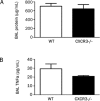Chemokine receptor CXCR3 is important for lung tissue damage and airway remodeling induced by short-term exposure to cigarette smoking in mice
- PMID: 20208554
- PMCID: PMC4007663
- DOI: 10.1038/aps.2009.192
Chemokine receptor CXCR3 is important for lung tissue damage and airway remodeling induced by short-term exposure to cigarette smoking in mice
Abstract
Aim: To investigate the role of chemokine receptor CXCR3 in cigarette smoking (CS)-induced pulmonary damage.
Methods: CXCR3 knockout (CXCR3-/-) mice were used. Differences in airspace enlargement, mRNA expression of matrix metalloproteinases (MMPs), transforming growth factor (TGF) beta1, CXCL10 in lung homogenates, and CXCL10 content in bronchoalveolar lavage (BAL) fluids and homogenates were compared between CXCR3-/- mice and wild-type (WT) mice three days after three-day CS exposures.
Results: The linear intercept was significantly less in CXCR3-/- mice than in WT mice (30.1+/-0.9 microm vs 40.3+/-2.4 microm, P<0.01). Morphologically, collagen was deposited less around airways and vessels in CXCR3-/- mice. The lung hydroxyproline content was significantly lower in CXCR3-/- mice than in WT mice (6.0+/-1.0 microg/mL vs 12.0+/-1.6 microg/mL, P<0.05). Profoundly lower mRNA expression of MMP2, MMP12, TGF beta 1, and CXCL10 was seen in lung homogenates from CXCR3-/- mice. CXCL10 concentrations in BAL fluid and lung homogenates were significantly lower in CXCR3-/- mice than in WT mice (BAL fluid: 19.3+/-1.4 pg/mL vs 24.8+/-1.6 pg/mL, P<0.05; lung homogenates: 76.6+/-7.0 pg/mL vs 119.5+/-15.9 pg/mL, P<0.05).
Conclusion: CXCR3 is important in mediating lung tissue damage and airway remodeling following a short-term CS insult, possibly through up-regulation of CXCL10 and inducement of mRNA expression of MMPs. Targeting CXCR3 may be helpful for prevention of CS-induced pulmonary pathology.
Figures





Similar articles
-
Acute pulmonary inflammation is inhibited in CXCR3 knockout mice after short-term cigarette smoke exposure.Acta Pharmacol Sin. 2008 Dec;29(12):1432-9. doi: 10.1111/j.1745-7254.2008.00899.x. Acta Pharmacol Sin. 2008. PMID: 19026162
-
Interleukin-22 exacerbates airway inflammation induced by short-term exposure to cigarette smoke in mice.Acta Pharmacol Sin. 2014 Nov;35(11):1393-401. doi: 10.1038/aps.2014.91. Epub 2014 Oct 27. Acta Pharmacol Sin. 2014. PMID: 25345745 Free PMC article.
-
[The pivotal role of CXCR3 in the pathogenesis of bleomycin-induced pulmonary fibrosis].Zhonghua Jie He He Hu Xi Za Zhi. 2005 Jan;28(1):28-32. Zhonghua Jie He He Hu Xi Za Zhi. 2005. PMID: 15774188 Chinese.
-
CXCL10/IP-10 in infectious diseases pathogenesis and potential therapeutic implications.Cytokine Growth Factor Rev. 2011 Jun;22(3):121-30. doi: 10.1016/j.cytogfr.2011.06.001. Epub 2011 Jul 29. Cytokine Growth Factor Rev. 2011. PMID: 21802343 Free PMC article. Review.
-
CXCL10 in psoriasis.Adv Med Sci. 2015 Sep;60(2):349-54. doi: 10.1016/j.advms.2015.07.011. Epub 2015 Aug 12. Adv Med Sci. 2015. PMID: 26318079 Review.
Cited by
-
Attenuation of antigen-induced airway hyperresponsiveness and inflammation in CXCR3 knockout mice.Respir Res. 2011 Sep 22;12(1):123. doi: 10.1186/1465-9921-12-123. Respir Res. 2011. PMID: 21939519 Free PMC article.
-
A Regulatory Role of Chemokine Receptor CXCR3 in the Pathogenesis of Chronic Obstructive Pulmonary Disease and Emphysema.Inflammation. 2021 Jun;44(3):985-998. doi: 10.1007/s10753-020-01393-9. Epub 2021 Jan 7. Inflammation. 2021. PMID: 33415536
-
New Pharmacological Tools to Target Leukocyte Trafficking in Lung Disease.Front Immunol. 2021 Jul 21;12:704173. doi: 10.3389/fimmu.2021.704173. eCollection 2021. Front Immunol. 2021. PMID: 34367163 Free PMC article. Review.
-
Soluble epoxide hydrolase inhibition reverses cognitive dysfunction in a mouse model of metabolic syndrome by modulating inflammation.Prostaglandins Other Lipid Mediat. 2024 Aug;173:106850. doi: 10.1016/j.prostaglandins.2024.106850. Epub 2024 May 10. Prostaglandins Other Lipid Mediat. 2024. PMID: 38735559 Free PMC article.
References
-
- Pauwels RA, Rabe KF. Burden and clinical features of chronic obstructive pulmonary disease (COPD) Lancet. 2004;364:613–20. - PubMed
-
- Chung KF, Adcock IM. Multifaceted mechanisms in COPD: inflammation, immunity, and tissue repair and destruction. Eur Respir J. 2008;31:1334–56. - PubMed
-
- Niewoehner DE, Kleinerman J, Rice DB. Pathologic changes in the peripheral airways of young cigarette smokers. N Engl J Med. 1974;291:755–8. - PubMed
-
- Bosken CH, Wiggs BR, Pare PD, Hogg JC. Small airway dimensions in smokers with obstruction to airflow. Am Rev Respir Dis. 1990;142:563–70. - PubMed
-
- Gelb AF, Hogg JC, Muller NL, Schein MJ, Kuei J, Tashkin DP, et al. Contribution of emphysema and small airways in COPD. Chest. 1996;109:353–9. - PubMed
Publication types
MeSH terms
Substances
LinkOut - more resources
Full Text Sources
Miscellaneous

